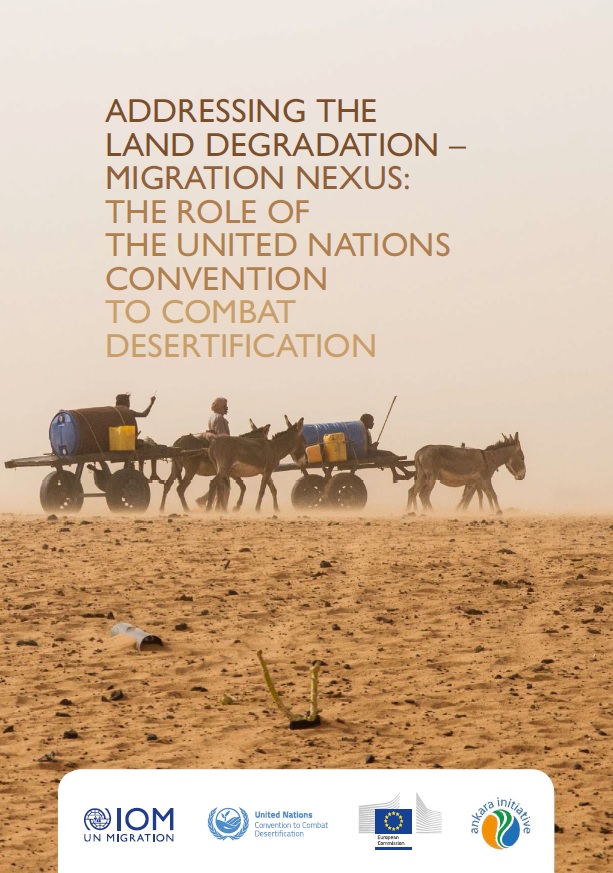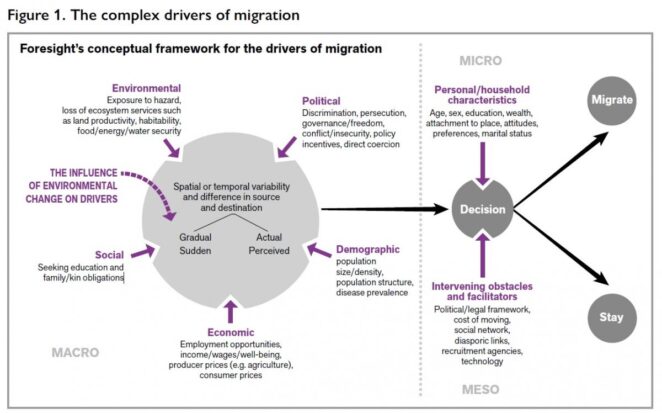Addressing the Land Degradation –Migration Nexus: the Role of the United Nations Convention to Combat Desertification

Introduction
Land is the central component upon which the livelihoods of humanity rely. Our food, energy, and jobs are all associated with, and dependent on, its quality and well-being. Land remains the most fundamental asset for the majority of rural populations living in developing countries, as their livelihoods are directly linked to agriculture. In the absence of decisive action to protect and restore vital land resources, there is a risk that desertification, land degradation and drought disproportionally contribute to increased poverty, unemployment and inequality; and lead to the forced migration of those already most marginalized and vulnerable.
This study results from the decision of States parties to the United Nations Convention to Combat Desertification (UNCCD) to produce a study on “The role that measures taken to implement the Convention can play to address desertification, land degradation and drought as one of the drivers that causes migration”. The study was commissioned to the International Organization for Migration (IOM) and prepared in partnership with the Stockholm Environment Institute (SEI).
*Download the full report from the right hand column. The key messages from the report are provided below. See the full text for much more detail.
The complex interrelationship between migration, desertification, land degradation, and drought
- Specific impacts of desertification, land degradation and drought on migration depend not only on people’s geographical exposure to risk, but crucially also on their pre-existing vulnerabilities.
- Within local populations impacted by the same environmental threats, vulnerability and likelihood to migrate are determined by a combination of factors, including socio-economic status, demographic characteristics (notably age and gender) and the migration, environmental, and resource management policies in place (see Figure 1).

- Most population movements in the context of desertification, land degradation and drought are short-distance and internal.
- However there is also evidence that international migration in search of employment can amplify at times of drought, especially in places with strong migration networks or traditions.
- Although migration has always been a vital strategy to cope with desertification, land degradation and drought, migration, in its forced forms,coupled with increased barriers to regular migration, can also contribute to further socio-economic and environmental vulnerabilities, rather than reduce them (see Figure 2).

- In this context, it is important to avert and minimize forced migration through interventions that address its drivers, including desertification, land degradation and drought. Considering that migration is often motivated by the search for better employment opportunities, making sustainable land management and ecosystem restoration compatible with the creation of dignified and attractive employment opportunities will be absolutely key to successfully avert and minimize forced migration connected to desertification, land degradation and drought.
Good practices and lessons learned
This section draws on a call for contributions launched by the UNCCD alongside a review of existing published evidence from around the world on good practices and lessons learned to combat desertification, land degradation and drought as a driver of migration; and enhance migration’s adaptive potential in the face of desertification, land degradation and drought. The following practices are reviewed in the report:
- On land protection and restoration
- Supporting small-scale farmers and agroecological practices
- Facilitating agroecological transitions in Benin
- Supporting integrated agricultural practices in Rwanda
- Supporting traditional coping strategies and agricultural terracing in Lebanon
- Encouraging a multi-level stakeholders approach to sustainable land management in Lebanon
- Developing community-based forest management
- On decent employment
- Reviving oases and enhancing livelihoods in Morocco and Tunisia
- Protecting biodiversity and livelihoods in the Atlantic Forest in Brazil
- Restoring degraded lands to ensure sustainable livelihoods in Indonesia
- On addressing pre-existing inequalities
- Protecting and recognizing land rights, incl. for indigenous peoples and local communities
- Supporting community initiatives in the Northern Mindanao in the Philippines
- Protecting and rehabilitating land to increase food security in Madagascar
- Enhancing women’s empowerment and social equality through land restoration
- On migration-related interventions
- Enhancing adaptive migration through land restoration in Ethiopia
- Supporting migrant reintegration through land restoration in Niger
- Supporting diaspora’s investments in sustainable land management in migration-prone areas in Burkina Faso, Niger and Senegal
- Protecting pastoralist mobility in Benin
- Facilitating access to land for refugees and other migrants in Uganda
The review of good practices shows that sustainable land management and land rehabilitation strategies that can avert and minimize forced migration take many varied forms depending on the local context. Those that are most successful share the following characteristics:
- Protect and restore fragile ecosystems through participatory approaches;
- Create abundant and dignified livelihood and employment opportunities;
- Tackle pre-existing vulnerabilities and inequalities.
Interventions that are usually best able to achieve these aims concurrently present the following characteristics:
- Strive to secure land rights and access to natural resources for those most vulnerable;
- Gender sensitive and empower the most marginalized;
- Support local knowledge;
- Reinforce local institutional capacities;
- Take into account specific local migration dynamics.
Policy recommendations
The third part of the report focuses on policy recommendations to avert, minimize and address the adverse consequences of desertification, land degradation and drought on migration. These recommendations speak to UNCCD Parties and other relevant stakeholders.
At the global level, enhanced cooperation between key international intergovernmental organizations dealing with migration, labour, environmental protection, climate change, development and agriculture will be key.
- In this respect, the study recommends further and enhanced collaboration between the UNCCD and the IOM, especially with regards to a collaborative implementation of the Global Compact for Safe, Orderly and Regular Migration.
- Synergies with the United Nations Framework Convention on Climate Change (UNFCCC) and the United Nations Convention on Biological Diversity (UNCBD) should also be strengthened to address the various factors at play in the migration desertification, land degradation and drought nexus.
- Given the cross-cutting nature of the migration-desertification, land degradation and drought nexus, the study also recommends increased collaboration between the UNCCD and other relevant UN agencies.
Considering that most migration in the context of desertification, land degradation and drought is either internal or regional, the UNCCD should support regional initiatives and bilateral cooperation between countries.
- This includes scaling-up existing state-led initiatives, such as the Initiative on Sustainability, Stability and Security (3S Initiative), which aims to create employment opportunities for vulnerable groups and migrants by restoring degraded lands and facilitating land access and tenure.
- Efforts should also be made to link up with other regional initiatives, including those taking into account pastoralist issues, such as the Economic Community of West African States (ECOWAS) and the Intergovernmental Authority on Development (IGAD) in Africa.
At the national level, it is essential that the ministries of migration, environment, agriculture, development and labour work in a collaborative and cross-cutting manner when implementing policies that affect any of these sectors, in order to avoid any potential negative trade-offs between them.
- In this respect, environmental and agricultural policies need to be aligned with migration policies that provide safe and regular migration pathways, and labour policies that create dignified employment opportunities; and vice-versa.
Finally, in terms of research and evidence, there is a need to strengthen the collection and dissemination of knowledge on the links between migration and desertification, land degradation and drought, including by:
- Encouraging longitudinal and comparative research;
- Promoting and facilitating multi-stakeholders co-production of knowledge approaches;
- Involving local researchers in all phases of research;
- Promoting further knowledge sharing on good practices.
This report was prepared by Sara Vigil, Research Fellow at the Stockholm Environment Institute (SEI), under the supervision of the International Organization for Migration and the United Nations Convention to Combat Desertification.
International Organization for Migration (IOM): The overall production and editing of this report was managed by Mariam Traore Chazalnoël, Specialist on Migration, Environment and Climate Change, with the support of Ileana Sînziana Pușcaș, Programme Support Officer for Migration, Environment and Climate Change; and under the overall supervision of Dina Ionesco, Head of Division, Migration, Environment and Climate Change.
United Nations Convention to Combat Desertification (UNCCD): This report was produced with the technical support provided by Barbara Bendandi, Programme Officer on Migration, and Norah Ng’eny, Associate Programme Officer, Regional Coordination Unit for Africa; and under the overall supervision of Louise Baker, Chief of External Relations and Policy. This report was produced with the financial support of the Directorate-General for the Environment of the European Commission and the Government of the Republic of Turkey, through the Ankara Initiative. This report has benefited from case studies identified through the technical assistance provided by the Secretariat of the Union for the Mediterranean and other stakeholders. Layout and design was provided by Carmelo Torres.
Suggested citation
International Organization for Migration and United Nations Convention to Combat Desertification (2019): Addressing the Land Degradation – Migration Nexus: The Role of the United Nations Convention to Combat Desertification. IOM, Geneva.
Related Articles
Related resources
- Environmental Migration Portal
- Migration as adaptation? A comparative analysis of policy frameworks
- Climate Change & Environment Nexus Brief: Migration
- Migration, Environment and Climate Change: Evidence for Policy (MECLEP)
- The climate change, migration and economic development nexus in North Africa: An overview
(0) Comments
There is no content